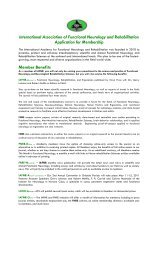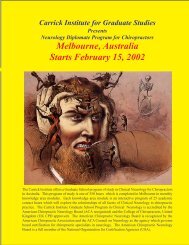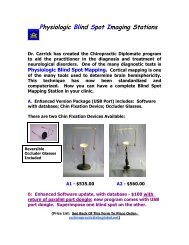Atlanta Brochure 1 - Carrick Institute for Graduate Studies
Atlanta Brochure 1 - Carrick Institute for Graduate Studies
Atlanta Brochure 1 - Carrick Institute for Graduate Studies
You also want an ePaper? Increase the reach of your titles
YUMPU automatically turns print PDFs into web optimized ePapers that Google loves.
806.. Autonomic Nervous System: Emphasis will be placed on the structure and function of the ANS in relationship to<br />
respiratory, cardiovascular, gastrointestinal, and genitourinary function and pathology. Autonomic concomitants associated<br />
with central and peripheral lesions will be reviewed. Clinical methodology involving diagnosis and treatment of<br />
neurological dysfunction of the ANS will be reviewed.<br />
807.. Cerebellar Cortices: Review of the major afferent and efferent projections of the cerebellum as well as the central/<br />
peripheral consequences of cerebellar pathology. The relationship of labyrinthine integration to occular movement will be<br />
discussed in detail with emphasis on its clinical application.<br />
808.. The Brain & Its Environment: Review of the internal and supportive structures of the brain with emphasis placed on<br />
the major afferent and efferent projections associated with brain activity. Lesions of the supportive structures of brain and<br />
the clinical methodology used in determining brain vascular integrity will be discussed. Applications specific to brain<br />
based treatments will be explored in detail.<br />
809.. Cranial Nerves: Complete review of the structure and function of the cranial nerves with emphasis on their clinical<br />
syndromes. Applications and procedures specific to this area of the nervous system will be covered in detail both didactically<br />
and practically.<br />
810.. Lobes of the Brain: Review the basic functions and structures associated with the frontal, parietal, temporal and<br />
occipital lobes. Methodology involving the use of optokinetic stimulations and other brain based diagnostics and therapeutics<br />
will be reviewed.<br />
811.. Neurological Diagnosis: Presentation of a structured <strong>for</strong>mat in approaching the neurological examination. Emphasis<br />
will be placed on reviewing the most common syndromes one may encounter during the practical portion of the exam as<br />
well as methodology to understand and apply non Cartesian logic.<br />
812.. Sensory Systems: The major sensory pathways will be discussed specific to their structure and function. Central<br />
processing of sensory in<strong>for</strong>mation will be reviewed in relationship to thalamic and cortical integration. Disorders of the<br />
sensorium will be reviewed and methodology introduced to aid in differentiating these disorders from central and peripheral<br />
origins. Applications specific to the treatment of the sensorium will be explored.<br />
813.. Pain: Pain generating mechanisms will be reviewed from the receptor to central processing. Central mechanisms <strong>for</strong><br />
pain inhibition and facilitation will be reviewed with emphasis placed on the clinical syndromes associated with pain<br />
integration. Methodology specific to chiropractic modalities will be reviewed as well.<br />
814.. Head & Face Pain: The most common syndromes involving head pain from migraines to trigeminal neuralgia will<br />
be reviewed. Afferent pain pathways from the face will be reviewed in regards to their structure and function. Applications<br />
specific to the facial pain sufferer will be presented.<br />
815.. Motor Systems: Discussion of the structure and function of the major volitional and non volitional motor pathways.<br />
Function of the basal ganglia, cerebral cortex, cerebellum, brainstem and spinal cord will be discussed in relationship to the<br />
human motor system. Applications specific to the diagnosis and treatment of both central and peripheral pathology will be<br />
covered.<br />
816.. Electrodiagnostics: Review of the general principles of electordiagnostic testing involving EMG, NCV, BAERS and<br />
VEP’s. The most common findings associated with these tests will be reviewed in light of various clinical syndromes. The<br />
utilization of these modalities in the clinical practice will be explored.<br />
817..Neurological Imaging: Presentation of a comprehensive inventory of diagnostic imaging specific to the neurological<br />
system. Methodology of interpretation of testing and practical applications complimentary to the neurological examination.<br />
818-823:Clinical Applications I, II, III, IV, V, VI: Presentation of applications specific to the disorders of the human<br />
nervous system. The candidate will learn how to apply advanced applications specific to all areas of the nervous system<br />
studied in the <strong>Graduate</strong> School Program of Clinical Neurology. These advanced modules will be based upon practicums<br />
and p and patient based paradigms.





